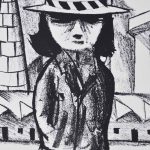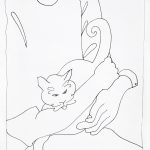Bus Stop – No. 58/90 (1984) – SOLD
Detail photos for this Artwork
Created in 1984 in a limited edition of only 90 prints, “Bus Stop” by Charles Blackman takes its inspiration from one of his most famous and distinctive bodies of work, the “Schoolgirls” series.
Produced between 1952 to 1955, the “Schoolgirls” pieces marked a turning point in Blackman’s career, and established him as one of Australia’s most important artists to emerge during the post-war era.
The Schoolgirl’s works are evocative depictions of big-eyed, uniformed schoolgirls in wide-brimmed hats, portrayed in oversized proportions. Blackman shows them walking or floating through deserted and eerie urban laneways, industrial settings, and in stark schoolyards.
The series is intriguing, because whilst there is immediate innocence evoked by the subject being schoolgirls, their placement in lonely, harsh industrial settings and the haunting long dark shadows cast by their figures and the surrounding architecture, creates an aura of unease and impending danger. It is as if their childhood innocence is threatened by the world once stepping out of the safety of their homes.
Blackman’s inspiration for the Schoolgirls series were derived from a range of sources.
In the early 1950s, when Blackman was in his early twenties, he and his wife Barbara were living in a converted stable in Hawthorn, Melbourne. Blackman recalled being “surrounded by thousands and thousands of schools and schoolgirls” in the nearby streets. These regular sightings inspired Blackman to create paintings and drawings of schoolgirls in a frenzy of work.
Other influences came from events within Charles and Barbara Blackman’s personal life.
In response to Barbara’s encroaching blindness, Charles had begun to routinely read to Barbara, intensifying the significance of the written word for them both.
In the early 1950’s Blackman discovered the lyrical poetry of John Shaw Neilson. Blackman says: “I didn’t actually start painting schoolgirls because Neilson wrote poems about them, but I found his poems when I was about halfway through this period and I thought them very beautiful … he had very bad eyesight and he used to write about things in a certain kind of way – he used to write about these things using these emotional powerful throbbing colours; they seemed to come out of the poems, you see, terrific things!’
Another source of inspiration was the tale of the “Gun Alley Murder” – a notorious murder in 1921 of 12 year-old schoolgirl, Alma Tirtschke, who at the time had been the dux of Hawthorn West Primary School.
Alma’s body was found in an alley near a popular wine saloon, close to the city’s Eastern Markets. The case was a media sensation, and police offered the biggest reward ever in Australia at that time to find Alma’s killer.
Colin Ross, the owner of a wine saloon near the laneway where Alma was discovered, was arrested and sentenced to death by hanging at the Old Melbourne Gaol in 1922. Ross had always protested his innocence and in 2006 the case was re-opened as new evidence emerged that absolved him of the murder. Ross was pardoned in 2008.
More than 30 years after the murder, in the 1950’s when Blackman began work on his Schoolgirl’s series, the Gun Alley site was being redeveloped, and Blackman responded to his memories of the case.
The initial exhibition of the ‘Schoolgirl series’ opened at the Peter Bray Gallery in Melbourne in May 1953 and an excerpt from a Shaw Neilson poem “Schoolgirls Hastening” was printed in the catalogue including the couplet: Schoolgirls hastening through the light / Touch the unknowable divine.
After the exhibition, art patrons John and Sunday Reid, founders of Melbourne’s Heide Museum of Modern Art acquired several Schoolgirls paintings, becoming the first major collectors of Blackman’s work.
Today the Schoolgirls paintings and drawings are dispersed across public and private collections in Australia, including: the Art Gallery of New South Wales, Heide Museum of Modern Art, Museum & Art Gallery of the Northern Territory, National Gallery of Australia in Canberra; National Gallery of Victoria; Parliament House Collection in Canberra; and the Tarra Warra Museum of Art in Victoria.
More by this artist
Back to All Art for Sale





























